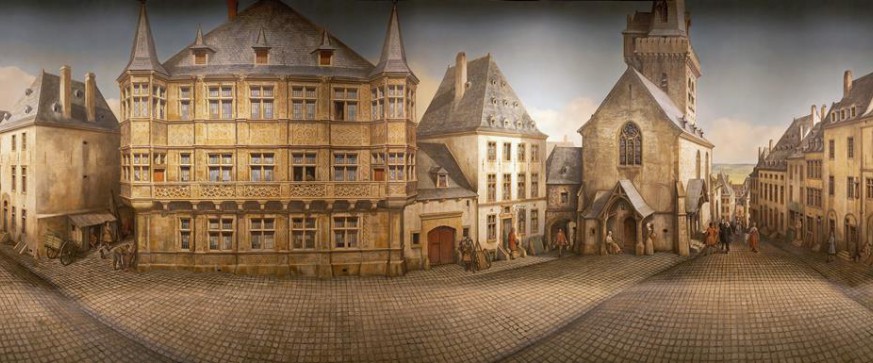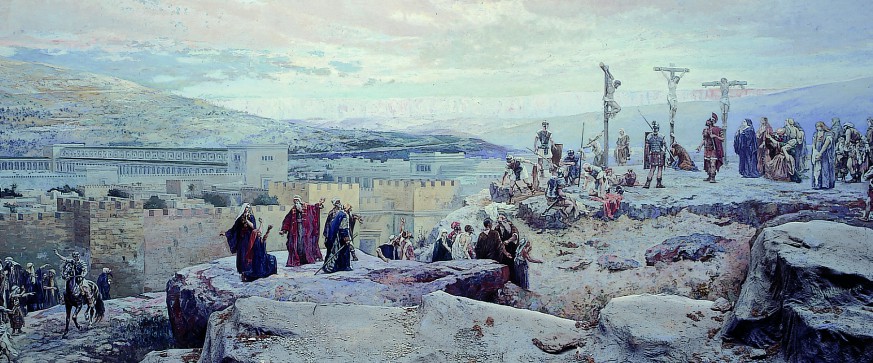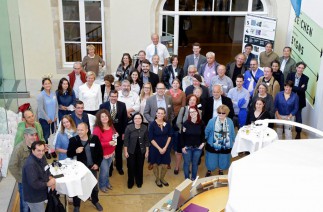The Executive Board of the International Panorama Council is pleased to look back on a fruitful conference with 50 participants from 16 different countries and 20 interesting presentations. The conference could have never been so successful without the intensive preparation work of our two Executive Board Dominique Hanson and Guy Thewes in cooperation with the IPC Secretariat and the local partners that included Axel Tixhon of the University of Namur, Isabelle Bondroit of the City of Namur and the Luxembourg History Museum.
- Panorama Rouen 1431
created by Yadegar Asisi in 2016
photo © asisi.jpg)
- Panorama Rotunda by Hittdorf
Paris, France in 1838 - Panorama of the Entry of the Magyars / Feszty-Panorama
Opusztaszer, Hungary
© Patrick Deicher - The City of Luxembourg in the 17th century (Artist: Antoine Fontaine)
Musée d'histoire de la Ville de Luxembourg, Luxembourg
© MHVL, Falk Eisleben
- Semi-circle Panorama 'The Berlin Wall' created in 2012 by Yadegar Asisi, © asisi, Tom Schulze
.jpg)
- e-cyclorama by Sanford Wurmfeld
exhibited in Edinburgh, Scotland in 2008.jpg)
- Jerusalem Panorama Crucifixion of Christ, Altötting, Germany, © Stiftung Panorama Altötting / photo H. Heine
.jpg)
- Wilpena Panorama created by Jeffrey B. Morgan, Hawker, Australia
- Diorama of the Conquest of Constantinople in 1453
Military Museum, Istanbul, Turkey
© Patrick Deicher - ICCI 360 Rotunda
seamless 360° film projection in a mobile rotunda
ICCI (Innovation for the Creative and Cultural Industries) with Plymouth University, UK
© Patrick Deicher.jpg)
- Panorama of Jerusalem and the Crucifixion of Christ, Einsiedeln, Switzerland

- Panorama Raclawice
Wroclaw, Poland
© Patrick Deicher
- Panorama of The Battle of Waterloo
Braine l'Alleud, Belgium
© Patrick Deicher.jpg)
- Interactive electronic panorama
exhibited in Luzern, Switzerland in 2010
© Patrick Deicher.jpg)
- Panorama of the City of Salzburg (Sattler-Panorama)
Salzburg, Austria
- Panorama of the Palace and Gardens of Versailles
Metropolitan Museum of Art, New York, USA
© Patrick Deicher
- Panorama of the Chibi War in 208
Wuhan, China
- Panorama of the Battle of Pleven
Pleven, Bulgaria
© Patrick Deicher
- Panorama of the Battle of Ji Nan
Ji Nan, China
- Panorama of the Battle of Mount Isel
TirolPanorama, Innsbruck, Austria
© Patrick Deicher
- Bourbaki Panorama
Luzern, Switzerland
© Emanuel Ammon.jpg)
- News
Looking back to the 24th International Panorama Conference
Saturday, 03 October 2015The theme of the 24th IPC conference was Layers of history: panoramas from classical to digital age. On the first arrival day of the conference the participants and Executive Board of the IPC were welcomed by Maxime Prévot, the mayor of Namur. This was followed by an opening speech of the panorama artist Yadegar Asisi in which Asisi used the conference theme to talk about the purpose of battle and war panoramas – then and now. He posed questions like: What is the purpose of restoring and conserving ancient battle and war panoramas? Why create and exhibit new panoramas showing military conflicts? And, can such panoramas be used as statements against war itself? Using his own panoramas of LEIPZIG 1813 and DRESDEN 1945 he explained his view on showing ‘war’ in a panorama. Not the siege itself are topics he addresses but he creates esthetic landscapes in order to enlarge the esthetics and suspense of the audience.
The first official conference day started with a welcome by Sara Velas, President of IPC. As we had lost two loved IPC members last year, there was time of remembrance of Ottó Trògmayer and Ralph Hyde. Dr. Róbert Károly Kiss gave a talk about the history of the Árpád Festztys cyclorama, “The arrival of the Hungarians” and Heritage Park where Ottó Trògmayer used to work and from where IPC started. At the General Assembly Gabriele Koller noted that the beautiful book of Ralph Hyde Paper peepshows was published and she also informed us about the interesting project that he still was working on, namely The ‘Biographical Dictionary of Panoramists of the English-Speaking World’. He gave his research material to The Bill Douglas Cinema Museum, you can read more about this project in this newsletter.
All our speakers were selected on their contribution to the theme of layers of history. Panoramas respond to our aspiration to recover lost worlds and revive the important events in history. Although to use them as a “time-machine” can be somewhat confusing. Most of them were made long after the moment in history they depict. The battles they show have been fought many years before the painter decided to fix them on canvas, the places represented have changed since then. A real ‘time-machine’ was found by PhD candidate Molly Briggs, who showed us a new discovered moving panorama made by Marcus Mote that is stored in the Krannert Art Museum on the Urbana campus of the University of Illinois. Together with a whole team she was responsible for the digitalization of this massive canvas and to do research on the story. She will keep us posted when the moving panorama will be displayed again. Suzanne Wray talked about the big business that the European capitalists achieved with their panoramas in America. In 2014 Dr. Alexy Druzhinin obtained his doctorate title with his thesis ‘Artistic diorama as a form of art in Russia’. In his talk he gave an interesting summary of his dissertation in which he studied the developments of diorama art in Russia. Prof. Thiago Leitão looked at the ways in which digital techniques can contribute in order to recreate lost panoramas. He discussed the panorama Del Retiro which was showed in the city of Buenos Aires in the late nineteenth century.
Today, the panoramas in themselves have become historical monuments, reflecting the particular time they were made. In the case of recently painted panoramas, the complexity can even be greater: using in the 21th century a 19th century medium for representing an historical scene. The conference proposed to explore the different layers of history contained in panoramas, revealing their changing meaning. Dr. Seth Thompson presented his research on cultural heritage. He looked at the representations of Versailles in France. In 1819 completed John Vanderlyn a painted panorama of Versailles which is now in the permanent exhibition of the Metropolitan Museum of New York. Thompson showed the ways in which this cultural site was used. Next to the painted panorama he placed the Google’s World Wonders Project of 2012 where he also looked at the visitors of Versailles nowadays and the differences between the representation of Vanderlyn and Google. The question of what to do with these layers of history were discussed in the paper of Dr. Gordon Jones. He told the history of the panorama of The Battle of Atlanta after it was made and how it was adjusted to the taste of the time and became in that way a confederate icon. Dr. Patrizia Kern Panoramas of the Battle of Gallipoli/ Çanakkale also had a similar point of view of looking at the different circumstances under which the panoramas of the Battle of Gallipoli / Çanakkale were realized and the political agendas and purposes behind the projects.
Large attention was also given to contemporary art and new media committed to the panoramic experience as a mean to cross time and space. Prof. Yunhui Ji of the Luxun Academy of Fine Arts of China gave a presentation of the Chinese panoramas. Hereby he showed that panoramas have special meanings and values in China. Dr. Magnus Moar and Mr. James Charlton took the panoramic experience to the 21st Century. In their paper they argued that the experience of viewing 360 degrees historical scenes, either within the real environment of the panorama or contemporary virtual environments, arise in part from the attraction of the immersive experience. Dr. Blagovesta Momchedjikova looked at pan-stereoramas, or better known as 3D scale models, of New York City and drew a distinction between the terms history and heritage, and ponder whether popular forms of entertainment concern themselves mostly with the latter. She showed the problems that occur with such a model that quickly gets outdated and showed the thin line between the question of history and heritage.
As Namur being the conference location we could not have a conference without talks on the two special still existing panoramas made by Alfred Bastien and in the possession of the Royal Military Museum of Brussels but stored in the military barracks of Namur. Dr. Natasja Peeters and Sandrine Smets, M.A. gave a talk on the history of Alfred Bastien’s panoramas the Yser Panorama and the Meuse Diorama. Prof. Axel Tixhon and dr. Bénédicte Rochet talked further on the developments and context of the Battle of the Meuse August 1914 as the last Belgian panorama. The question of what to do with a remaining diorama and even the existing of the original building was the question for Claire Barbier, M.A. and Aurore de Bruyn, M.A. whose talk was entitled The diorama Battle of the Meuse; restoration prospects in the 21th century.
Novelties
A novelty this year was the presence of artists during the coffee breaks. This way the participants really got the time to take the time to crank the crankie of Sue Truman’s Crankies Factory and look at the presentation of Patricia Lambertus’ panoramic artworks. Also new was the conference table on which all the participants were allowed to leave their brochures or other panorama-related commercial information.
Cultural program
As the regular IPC conference participants are used to, IPC conferences also have an extensive cultural program. Being in Namur was an excellent opportunity to visit the St. Aubain Cathedrale where we were invited by the Warsaw Academy of Fine Arts to the curvilinear Loder’s painting “Adoration of the Magi”. During the conference Katarzyna Górecka, Dr. Marek Sklodowski and Dr. Piotr Pawlowski prepared a paper in which they gave an insight on the work they had done. The presentation focused on experimental research and theoretical analysis of fundamentals of stretching of large curvilinear canvasses.
The theme of the conference came together in the Luxembourg History Museum where the participants could visit a panorama of Luxembourg in two ways. On the one hand this was the actual painted panorama made by the scenic artist Antoine Fontaine. But on the other hand the participants could also walk through the City of Luxembourg of the nineteenth century via Second Life via an Occulus Rift (immersive digital glasses). Dr. Guy Thewes and Antoine Fontaine talked about the developments of this small panorama of the City of Luxembourg and the reasons why the Museum decided to choose a panorama for their exhibition setting. In the evening we were treated on a lovely dinner which was supported by the City of Luxembourg.
Unfortunately the state of the dioramas Battle of the Meuse and Battle of the Yser disallowed the group to visit these dioramas. But the visit to the original building, where the Battle of the Meuse originally was displayed gave an idea of the immense measurements of the canvas.
The post conference tour to Waterloo was - despite of the rain - a beautiful visit. Since May 2015 the Museum reopened its doors with a whole new multi-media exhibition. The conservation team of the panorama of the Battle of Waterloo took us on a tour to the ‘behind the scenes’ of the panorama.
After a well organised lunch in the new Wellington café (the building of this new lunchroom was placed on the old fundaments of the wax museum) we said goodbye to our participants and promised to see each other next year in Hungary.

.jpg)

